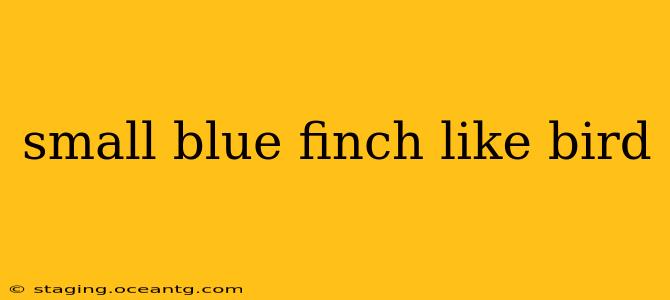Identifying small, blue birds can be tricky! Many species share similar characteristics, making accurate identification crucial for birdwatchers and nature enthusiasts alike. This guide helps you pinpoint the small, blue finch-like bird you've spotted, focusing on key features and common look-alikes.
What are some small blue finch-like birds?
This depends heavily on your geographic location. The term "finch-like" implies a small, seed-eating bird with a conical beak. However, several bird families contain small, blue species that might fit this description. Some examples include:
- Indigo Buntings (Passerina cyanea): These are a classic example – striking males are a deep, vibrant blue. Females are much more subdued, brownish with hints of blue. Found in North America.
- Blue Grosbeaks (Passerina caerulea): Larger than Indigo Buntings, with a thicker, more robust bill. Males are a rich, deep blue, while females are a mottled brown and blue. Also found in North America.
- Lazuli Buntings (Passerina amoena): Males display a beautiful blue back, chestnut-colored breasts, and two distinct white wing bars. Found in western North America.
- Various Blue Tits (Cyanistes spp.): These are found across Europe and Asia. They are small and active, often found in flocks, and have a characteristic blue crown and wing markings. Their size and behavior differ from finches.
- Several species of Bluebirds: While not strictly finches, bluebirds share a similar size and might be mistaken for one, especially from a distance. Again, geographic location is key for identification. Eastern Bluebirds (Sialia sialis), Mountain Bluebirds (Sialia currucoides), and Western Bluebirds (Sialia mexicana) exhibit various shades of blue.
What are the key features to look for?
To accurately identify a small, blue finch-like bird, pay close attention to these details:
- Size and Shape: How big is the bird relative to other birds in the area? Note the overall body shape – slender and elongated like a finch, or more stout?
- Color and Pattern: The exact shade of blue is vital. Is it a deep indigo, a lighter azure, or a more turquoise hue? Are there other colors present, such as brown, chestnut, or white? Look for wing bars, breast markings, or other distinctive patterns.
- Bill Shape: A conical bill is typical of finches, used for cracking seeds. Observe the size and shape carefully.
- Habitat: Where did you see the bird? Different species prefer specific habitats (woodlands, grasslands, etc.).
- Behavior: Was the bird foraging on the ground or in trees? Was it alone or in a flock? Its behavior can provide clues.
What other small blue birds are there?
Many other small blue birds exist, though they may not perfectly fit the "finch-like" description due to differences in size, bill shape, or family. Examples include:
- Verdins (Auriparus flaviceps): Small, yellowish-green birds with some blue tints found in the southwestern United States and Mexico.
- Blue-gray Gnatcatchers (Polioptila caerulea): Tiny, active birds with a long tail and a blue-gray back.
- Northern Mockingbirds (Mimus polyglottos): While primarily gray, they can display blueish hues in certain lighting.
How can I use a field guide or app for identification?
Field guides and bird identification apps are invaluable resources. Many are available, both digitally and in print. Use the features described above to narrow down your options within the app or guide. Pay close attention to range maps to confirm if the species is found in your area.
Remember, precise identification sometimes requires careful observation and a bit of detective work. Comparing your observations to detailed descriptions and images in a reputable field guide will significantly improve your chances of success. Don't be afraid to consult with local birding groups or experts for help with difficult identifications.
